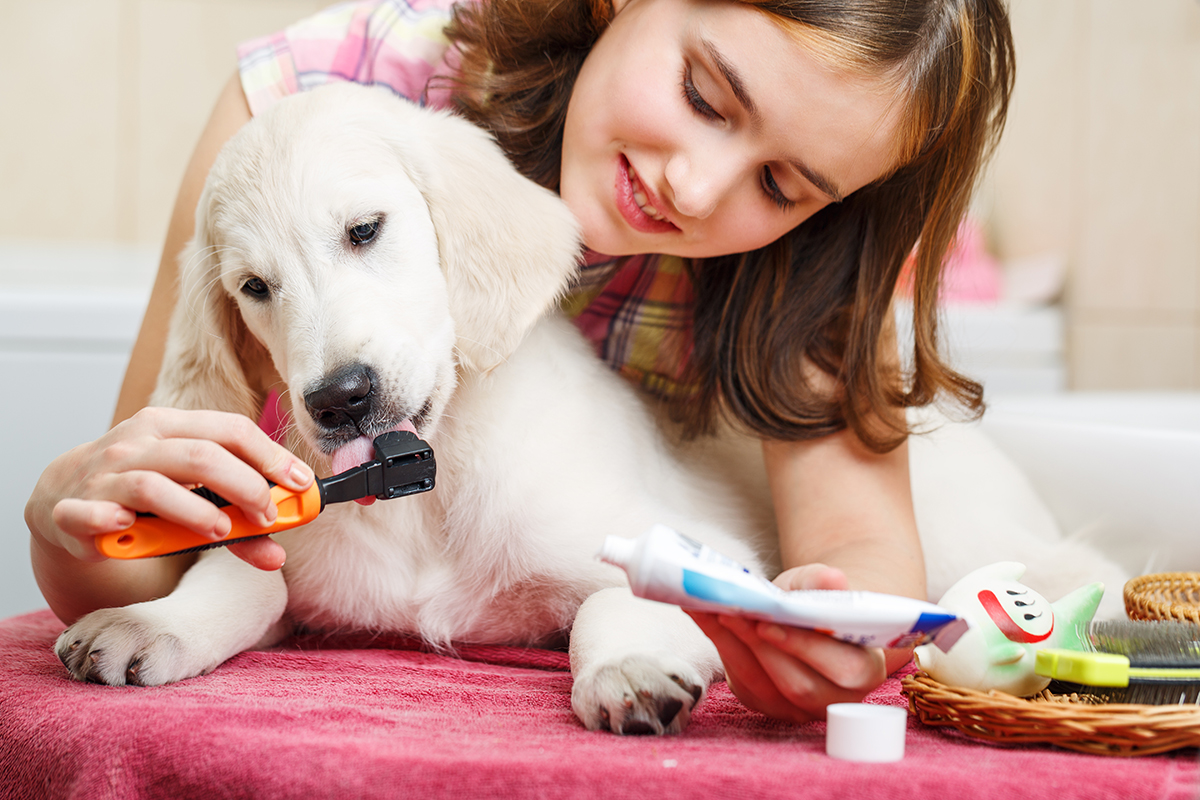Keep their teeth and gums clean
Proper dental hygiene can greatly prolong your pet’s life, while improving their overall well being. Unfortunately, tooth decay, plaque buildup and poor dental hygiene are very common in cats and dogs.
It’s not just mouth related issues you need to worry about, either. Infections in the gums can spread to the heart and kidneys, greatly reducing your pet’s quality of life.
Cleaning your dog’s teeth is pretty easy once you work out a routine. Keep in mind:
- You don’t need to brush them every day
- Never use human toothpaste
- It might take some time and training in the beginning.
To get started, purchase a specially made double headed toothbrush and toothpaste set for your dog, or talk to your vet about the best options for your pet.
If your cat or dog already has tooth problems, you should talk to your vet immediately. Signs include bad breath, pawing at the face and reticence to eat food. Even if your pet does need some teeth removed, it’s a much better solution than risking infection over the long term.
Here are some more detailed tips on looking after your pet’s teeth and gums http://www.petsecure.com.au/pet-care/essential-tips-looking-pets-teeth-gums/
Maintain a healthy weight
Obesity issues don’t just affect humans. Cats and dogs can suffer from weight related illness, particularly when they are overfed and under exercised. If you’re in any doubt, consider the first thing most vets do during a check up is weigh your dog. That’s because excess weight can lead to a whole range of quality of life affecting issues, from heart disease to joint issues and reduced mobility.
It’s not hard for a pet to put on extra weight. For example, a dog whose ideal weight is 10 kilograms only needs to put on an extra 2 kilos to to have 20% extra body weight. Dogs also come in all shapes and sizes, from petite 1 kilogram maniacs to 70 kilogram sweethearts, further complicating the average weight for a dog.
To ensure your pet is at their ideal weight, it takes a combination of healthy food, reasonable portion sizes and regular exercise. Your pet is dependent on you for healthy, wholesome food, so if there is any doubts talk to your vet about the ideal weight, exercise and food consumption for your cat or dog.
Here’s how you can tell if your pet is overweight http://www.petsecure.com.au/pet-care/is-your-pet-overweight/
Exercise regularly and safely
Dogs are pack animals, descended from wolves that roamed far and wide. And though a domestic cat is small, there’s no denying the hunter instincts of an alpha predator that run through their veins. Just like humans, all animals need engaging, healthy exercise, and just like humans, many tend not to get enough.
The best kind of exercise for your pet will largely depend on their species and breed. For example, though greyhounds are among the speediest pets on four legs, they only need a light walk to be happy. Meanwhile, a cattle dog is going to need lots of games and exercise to burn off their energy.
Cats also have their own needs. While walking a cat is fine, they also like games that challenge their hunter instincts. The ‘bored cat’ is usually one just waiting to strike!
Always exercise your pet. Lack of exercise can lead to health issues, anxiety and misbehaviour. If you don’t have the time and patience to exercise your pet, consider a professional dog walking service.
Keep your pets vaccinated
Vaccinating your dog or cat early will prevent them from contracting many animal related diseases. Some vaccinations, like vaccination against kennel cough, might need to be updated every few years. Talk to your vet about the appropriate vaccination schedule for your dog or cat and remember the old adage ‘prevention is better than a cure’.
Proper supervision and training
The modern world is full of pet hazards. From zooming cars to toxic foods, bait poisons, predators, allergies and diseases.
Keeping your dog safe from harm comes down to a combination of supervision and training. Teaching your dog to respond to commands correctly and reliably will help keep them out of danger. Practicing walking on leash is also important. Unless you’re in a safe place like a dog park, trail or around the home, your dog should be kept on leash to prevent any sudden distractions or dangers.
Cats can also be harnessed when outside, This not only keeps them safe, but protects natural wildlife from the hunting instincts of your kitty. Because cats don’t respond to commands as well as dogs, it’s important to keep them secured at all times, as once they’re loose, it’s much harder to control them with verbal commands and treats.
Get regular checkups
Animals are good at hiding pain. For a pet, there’s no such thing as a sick day. So it’s important to get regular check ups to make sure you are healthy and happy. For most pets, this should be at least once a year. As your pet gets older, they might need to go more often. When at the vet, they can advise you of any dietary or habit changes needed to keep your dog healthy.
Don’t forget personal space
Like people, cats and dogs need their own space, downtime and a chance to rest, sleep and relax. Giving your pet it’s own bed, crate or mat to sleep on is important. Equally important is treating that space as their personal area where they can relax in comfort and security. That means educating children (and adults) to respect your dog’s personal space and understand when a dog is resting and recuperating.







Leave A Comment